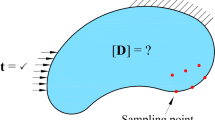Summary
An analytical comparison is made of a stress-activated nonlinear model (E) and a linear spectral model (M) for visco-elastic bodies in relaxation, creep, relaxation-creep recovery, constant strain-rate extension and periodic strain. A special reason for this is an observed “invariance” in relaxation (eq. [1]). Significant parameters are the frequency functionH for (M) and the rate constantα for (E).H should be roughly constant in relaxation and in still rougher approximation also in creep recovery, whileα should be inversely proportional to the stress and in additionα (creep-recovery)/α (relaxation) ≈ 22. For strain extension both models predict similar results but none takes the plastic creep of large rate in consideration. Regarding periodic strain model (M) gives a conventional behaviour, while model (E) predicts significant time dependent frequency effects.
Possible physical mechanisms for explanation of the results obtained are discussed.
Zusammenfassung
Ein analytischer Vergleich von einem spannungsaktivierten nichtlinearen Modell (E) und einem linearen Spektralmodell (M) für visco-elastische Körper in Relaxation, Kriechen, Relaxationkriecherholung, Dehnung mit konstanter Geschwindigkeit und periodische Dehnung wird gemacht. Eine spezielle Ursache dafür ist eine „Invarianz“ in der Relaxation [1]. Signifikante Parameter sind die FrequenzfunktionH für (M) und die Geschwindig-keitskonstanteα für (E).H sollte in grober Näherung in der Relaxation konstant sein und in noch gröberer Näherung auch in Kriecherholung.α sollte aber im inversen Verhältnis zur Spannung stehen, und weiter sollteα (Kriecherholung)/α (Relaxation) ≈ 22 sein. Für Dehnung geben beide Modelle ungefähr dieselben Resultate, keines nimmt aber das plastische Kriechen von größerer Geschwindigkeit in Betracht. Für periodische Dehnung sieht (M) ein konventionelles Verhalten voraus, für (E) findet man aber signifikante zeitabhängige Frequenzeffekte.
Mögliche physikalische Mechanismen zur Erklärung der Resultate werden diskutiert.
Similar content being viewed by others
References
Bartenev, G. M. andYu. S. Zuyev, Strength and Failure of Visco-Elastic Materials, p. 189 (Oxford 1968).
Cherry, B. W. andP. L. McGinley, Appl. Polymer Symposia No.17, 59 (1971).
Cottrell, A. H., Theory of Crystal Dislocations, p. 57 (1962).
Ferry, J. D., R. F. Landel andM. L. Williams, J. Appl. Physics26, 359 (1955).
Friedel, J., Dislocations, p. 67 (Oxford 1964).
Gilman, J. J., Physics of Strength and Plasticity, p. 3 (1969).
Gross, B. andH. Pelzer, J. Appl. Physics22, 1035 (1951).
Irving, J. andN.Mullineux,Mathematics in Physics and Engineering, p. 599 (New York 1959).
Jahnke andEmde, Tables of Higher Functions (1948).
Joshi, V. S. andN. R. Kothari, Text. Res. J.40, 764 (1970).
Kubát, J., A Similarity in the Stress Relaxation Behaviour of High Polymers and Metals. (Diss.) (Stockholm 1965).
Kubát, J., IV. Int. Congr. Rheology, Part 1, 281 (1963).
Kuhlmann-Wilsdorf, D., Phys. Review120, 773 (1960).
Leibfried, G. andW. Ludwig, Solid State Physics12, 365 (1961).
Müller, F. H., Rheology V, p. 447 (New York 1969).
Olofsson, B., Deformation and Recovery Properties of Textile Materials. (Diss.) (Gothenburg 1968).
Olofsson, B., To be published.
Zimm, B. H., Rheology III, p. 1 (New York 1960).
Author information
Authors and Affiliations
Additional information
With 6 figures and 1 table
Rights and permissions
About this article
Cite this article
Olofsson, B. Comparison of stress-activated models and linear spectral models for visco-elasticity. Rheol Acta 13, 78–85 (1974). https://doi.org/10.1007/BF01526888
Received:
Issue Date:
DOI: https://doi.org/10.1007/BF01526888




